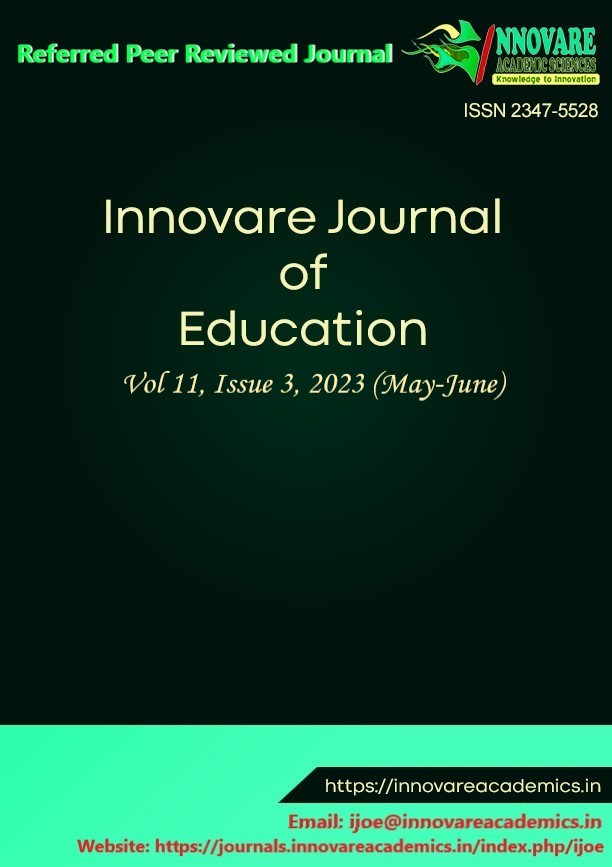Scaffolding Epistemological Access in the Context of Forbidden Discourses: A Case Study of a Grade 4 Natural Science Class in a Namibian School
DOI:
https://doi.org/10.22159/ijoe.2023v11i3.47647Keywords:
agency, culture, epistemological access, science learning, structureAbstract
Qualitative in orientation and using the case study methodology, the research drew upon Margaret Archer’s theory of agency to examine how, at the point of confluence of culture, structure and agency, the teacher’s agency was enabled or constrained in attaining the agential project of scaffolding epistemological access in a Grade 4 Natural Science classroom. The study found that when positioned into a face-to-face relationship, or a direct relationship, with the structural, cultural, and agential causal powers, the teacher’s agential project of scaffolding epistemological access in a Grade 4 Natural Science classroom was constrained than enabled. The teacher was placed into a pedagogical dilemma where on the one hand, structural causal powers (e.g., the curriculum, syllabus, school authorities) demanded the teaching of topics on human sexual reproduction and human excretory systems. At the same time, causal cultural powers exerted by cultural properties, which include values, norms, and taboos, render conversation with young children over sexual reproduction matters and human excretory system forbidden discourses. The study concluded that cultural factors are among the myriad factors that potentially lead to poor performance in Natural Science by Namibian learners and African learners in general. The study recommends that in teacher education programs, it is essential to interrogate the school curriculum regarding its sensitivity and responsiveness to the cultural contexts of both teachers and learners. Similarly, such programs should investigate developing appropriate agential powers of aspiring teachers to resist or circumvent causal cultural powers that obstruct or hinder meaningful science learning.
Downloads
References
Alshenqeeti, H. (2014). Interviewing as a data collection method: A critical review. English Linguistics Research, 3(1). https://doi.org/10.5430/elr.v3n1p39
Archer, M. S. (1995). Realist social theory: The morphogenetic approach. Cambridge University Press. https://doi.org/10.1017/CBO9780511557675
Archer, M. S. (1996). Culture and agency: The place of culture in social theory (2nd ed.). Cambridge University Press. https://doi.org/10.1017/CBO9780511557668
Bairagi, V., & Munot, M. V. (2019). Research methodology. CRC Press.
Banda, F. (2016). Towards a democratization of new media spaces in multilingual/multicultural Africa: A heteroglossic account of multilocal and multivoiced counter-hegemonic discourses in Zambian online news media. Linguistics Plus, 49. https://doi.org/10.5842/49-0-686
Banda, F. (2018). Translanguaging and English-African language mother tongues as linguistic dispensation in teaching and learning in a black township school in Cape Town. Current Issues in Language Planning, 19(2), 198–217. https://doi.org/10.1080/14664208.2017.1353333
Bryman, A. (2012). Social research methods (4th ed.). Oxford University Press.
Bucher, H. J., & Niemann, P. (2012). Visualizing science: The reception of power point presentations. Visual Communication, 11(3), 283–306. https://doi.org/10.1177/1470357212446409
Burke, R., & Christensen, L. (2014). Educational research: Quantitative, qualitative, and mixed approaches (5th ed.). SAGE Publications.
Creswell, J. W., & Creswell, D. J. (2018). Research design: Qualitative, quantitative, and mixed methods approaches (5th ed.). SAGE Publications.
Creswell, J., & Poth, C. N. (2018). Qualitative inquiry and research design: Choosing among five approaches (4th ed.). SAGE Publications.
Crowe, S., Cresswell, K., Robertson, A., Huby, G., Avery, A., & Sheikh, A. (2011). The case study approach. BMC Medical Research Methodology, 11, 100. https://doi.org/10.1186/1471-2288-11-100
Danermark, B., Ekström, M., & Karlsson, J. Ch. (2019). Explaining society: Critical realism in the social sciences (2nd ed.). Routledge.
Dobson, P., Jackson, P., & Gengatharen, D. (2013). Critical Realism in research explaining broadband adoption in rural Australia: Modes of reflexivity and the morphogenetic approach (37th ed.). Edith Cowan University.
Gibbons, P. (2003). Mediating language learning: Teacher interactions with ESL students in a content-based classroom. TESOL Quarterly, 37(2), 247. https://doi.org/10.2307/3588504
Gibbons, P. (2006). Bridging discourses in the ESL classroom: Students, teachers, and researchers. Continuum.
Gustafsson, J. (2017). Single case studies vs multiple case studies: A comparative study.
Lemke, J. L. (1990). Talking science: Language, learning, and values. Ablex Publishing Corporation.
Makuwa, D. K., & Maarse, J. (2013). The impact of large-scale international assessments: A case study of how the ministry of education in Namibia used SACMEQ assessments to improve learning outcomes. Research in Comparative and International Education, 8(3), 349–358. https://doi.org/10.2304/rcie.2013.8.3.349
Malsbary, C. B. (2016). Qualitative research in super-diverse schools. International Journal of the Sociology of Language, 2016(241), 9-37. https://doi.org/10.1515/ijsl-2016-0021
Miles, M. B., Huberman, Michael, A., & Saldaña, J. (1994). Qualitative data analysis a methods sourcebook (4th ed.). SAGE Publications.
Mutorwa, J. (2004). National report on the development of education in Namibia. In Proceeding of International Conference on Education (16-21). Geneva.
Quinn, L. (2012). Re-imagining Academic Staff Development: Spaces for Disruption. Sun Press.
Ramadhan, M. K. (2018). A critical analysis of the establishment, conceptualization, design and curriculum component selection of Master of Education programmes at selected Tanzanian universities (Doctoral thesis, Rhodes University, Makhanda, Eastern Cape Province, South Africa). Seals. http://hdl.handle.net/10962/62214
Roschelle, J. (2000). Choosing and using video equipment for data collection. In E. Kelly & R. Lesh. Handbook of research design in mathematics and science education (pp. 709-731). Erlbaum.
Williams, L. H., & Montgomery, S. K. (2018). Synthesizing proximate and distal levels of explanation: Toward an evolution-informed sociology. Frontiers in sociology, 3(15), 1-15. https://doi.org/10.3389/fsoc.2018.00015
Wolfaardt, D. (2005). Namibia: A case for a gradual transitional bilingual language programme. In J. Cohen, K. T. McAlister, K. Rolstad, and J. MacSwan (Eds.) Proceedings of the ISB4: 4th International Symposium on Bilingualism. Somerville, USA.
Yin, R. K. (2018). Case study research and applications: Design and methods (6th ed.). SAGE Publications.
Published
How to Cite
Issue
Section
Copyright (c) 2023 Beata Set, John Nyambe, Kelvin Katukula

This work is licensed under a Creative Commons Attribution 4.0 International License.





